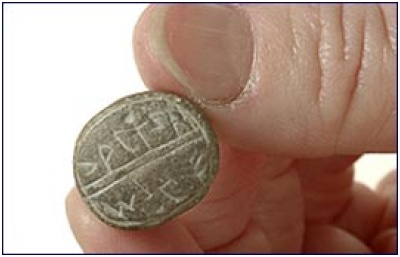8th Century BCE Seals Found At City Of David Site
Seals dating to the 8th Century BCE found at City of David excavations
Finds recovered from the excavations in the City of David reveal an interesting development in the ancient world: whereas during the 9th century BCE letters and goods were dispatched on behalf of their senders without names, by the 8th century BCE the clerks and merchants had already begun to add their names to the seals.

Complete seal bearing the
Hebrew name "Rephaihu (ben) Shalem".
(Photo: Israel
Antiquities Authority)
In an excavation the Israel Antiquities Authority is conducting in cooperation with the Nature and Parks Authority and the Elad Association in the City of David, in the National Park around the Old City Walls of Jerusalem, artifacts were found that include, among other things, a complete seal that bears the Hebrew name "Rephaihu (ben) Shalem" and fragments of bullae. The excavation directors are Professor Ronny Reich of the University of Haifa and Eli Shukron of the Israel Antiquities Authority.
In an archaeological excavation that is being carried out at the Spring House near the Gihon Spring in the City of David, soil was excavated which contained pottery sherds that date to the Iron Age 2 (8th century BCE).
Wet sifting and carefully sorting through the soil produced the hoped for results: fragments of three bullae (pieces of clay that were meant to seal letters or goods), and two stone seals were recently found. All of the objects bear Hebrew names and all date to the 8th century BCE. Among them is a seal that was discovered intact and which bears the Hebrew name "Rephaihu (ben) Shalem", who lived in the City of David in Jerusalem during this period. The seals were primarily used by public officials.
According to the researchers, Eli Shukron and Professor Ronny Reich, "In contrast with the large cluster of bullae that was found two years ago, in which all of its items contain graphic symbols (such as a boat or different animals - fish, lizards and birds) but are of an earlier date (end of the 9th-beginning of the 8th century BCE), the new items indicate that during the 8th century BCE the practice had changed and the clerks who used the seals began to add their names to them."
ENDS
Latest World News | Top World News | World Digest | Archives | RSS


 European Cultural Centre: Time Space Existence 2025 - A Collective Call To Repair, Regenerate, And Reuse
European Cultural Centre: Time Space Existence 2025 - A Collective Call To Repair, Regenerate, And Reuse John P. Ruehl, IMI: What Will Tech Moguls Do With Their Wealth?
John P. Ruehl, IMI: What Will Tech Moguls Do With Their Wealth? ITUC: Workers Must Not Pay The Price Of An Imposed Trade War
ITUC: Workers Must Not Pay The Price Of An Imposed Trade War Greenpeace: Major Deep Sea Mining Company Goes Bankrupt
Greenpeace: Major Deep Sea Mining Company Goes Bankrupt New Zealand Defence Force: Indian And New Zealand Navies Involved In $181m Drug Bust In Indian Ocean
New Zealand Defence Force: Indian And New Zealand Navies Involved In $181m Drug Bust In Indian Ocean Google Cloud Security: North Korea’s Expanding IT Threat - NZ And Other Nations In The Crosshairs
Google Cloud Security: North Korea’s Expanding IT Threat - NZ And Other Nations In The Crosshairs